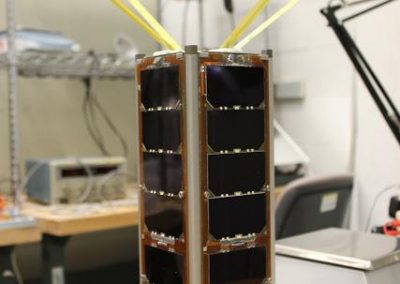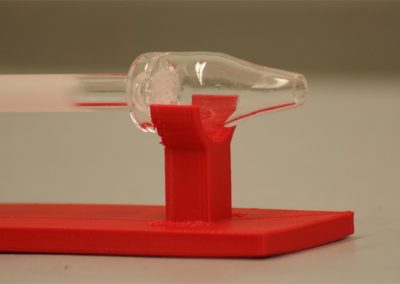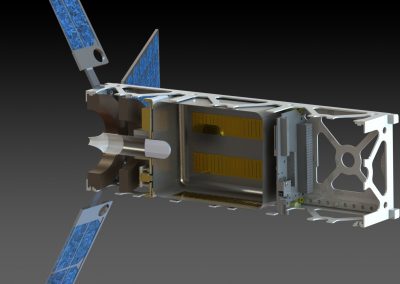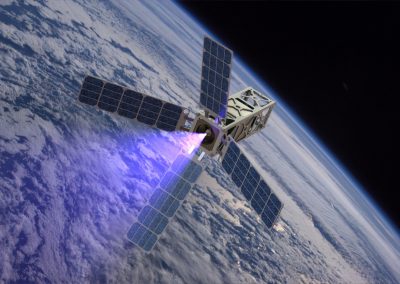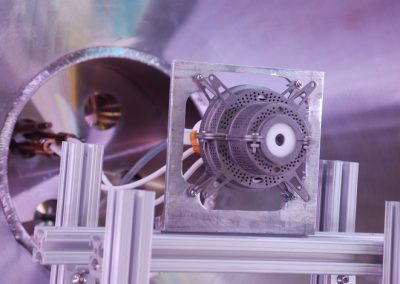Thruster
CubeSat Ambipolar Thruster (CAT)
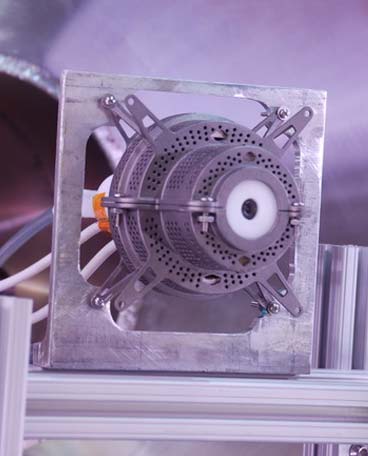
CAT being set up for an experiment
Developed
2013
Tested at PEPL
2013 – 2016
Developer
PEPL, NASA, DARPA, Phase Four Inc.
The CubeSat Ambipolar Thruster (CAT) is a thruster designed as a propulsion system for CubeSats. It relies on a radio frequency antenna to create a plasma in a ceramic liner. The radiofrequency wave efficiently ionizes the Xenon propellant and heats the electrons. Through the process of ambipolar diffusion, these electrons exit the generation region at high speeds. The resulting charge imbalance provides an electric field that accelerates the ions, generating thrust.
To further convert the electron thermal energy into thrust, a magnetic nozzle is applied. A magnetic nozzle consists of a diverging magnetic field that forces the plasma to expand outwards as well, cooling it and converting its thermal energy into directed thrust. The nozzle also induces azimuthal electron currents which in turn produce a magnetic field in the direction opposite of the nozzle. In this manner, the electrons form an electromagnet that pushes off of the thruster magnetic field, enhancing thrust.
Furthermore, CAT will be able to operate on a wide range of propellants. While a supply of Xenon is still ideal, it is difficult to bring such a supply into space. For extended missions throughout the solar systems, small thrusters must be able to adapt to whatever propellant they have nearby, a concept known as In-Situ Resource Utilization, ISRU. A thruster able to use a variety of propellants such as CAT will extend the range of small satellite missions.
Selected Publications
Performance of the H9 Magnetically Shielded Hall Thrusters
Cusson, S. E., Hofer, R. R., Lobbia, R. B., Jorns, B. A., and Gallimore, A. D.
The H9 Magnetically Shielded Hall Thruster
Hofer, R.R., Cusson, S.E., Lobbia, R.B., and Gallimore, A.D.
Dispersion relation measurements of plasma modes in the near-field plume of a 9-kW magnetically shielded thruster
Brown, Z. A., and Jorns, B. A.
Experimental Evidence for Ion Acoustic Solitons in the Plume of a Hollow Cathode
Georgin, M.P., Jorns, B.A., and Gallimore, A.D.
Ion Acoustic Turbulence in the Hollow Cathode Plume of a Hall Effect Thruster
Cusson, S.E., Brown., Z, Dale, E.T., Jorns, B.A., and Gallimore, A.D.
Non-Invasive Characterization of the Ionization Region of a Hall Effect Thruster
Dale, E.T. and Jorns, B.A.
Spatial Evolution of Plasma Waves in the Near-field of a Magnetically Shielded Hall Thruster
Brown, Z. and Jorns, B.A.
Impact of Neutral Density on the Magnetic Shielding of Hall Thrusters
Cusson, S.E., Jorns, B.A., and Gallimore, A.D.
Two-zone Hall thruster breathing mode mechanism, Part II: Experiment
Dale, E.T., and Jorns, B.A.
Experimental Correlation between Anomalous Electron Collision Frequency and Plasma Turbulence in a Hall Effect Thruster
Brown, Z.A, Dale, E., and Jorns, B.A.
Non-invasive in situ measurement of the near-wall ion kinetic energy in a magnetically shielded Hall thruster
Cusson, Sarah E.
Performance of a 9-kW Magnetically-Shielded Hall Thruster with Krypton
Leanne L. Su , Alexander R. Vazsonyi and Benjamin Jorns
Performance Comparison of a 9-kW Magnetically-Shielded Hall Thruster Operating on Xenon and Krypton
Leanne L. Su and Benjamin A. Jorns
Operation and Performance of a Magnetically Shielded Hall thruster at Ultrahigh Current Densities on Xenon and Krypton
Leanne L. Su, Tate M. Gill, Parker J. Roberts, William J. Hurley, Thomas A. Marks, Christopher L. Sercel, Madison G. Allen, Collin B. Whittacker, Mathew P. Byrne, Zachariah B. Brown, Eric Viges, and Benjamin A. Jorns
Design of an Air-Core Magnet Circuit for a Hall Thruster
William J. Hurley, Thomas A. Marks, and Benjamin A. Jorns
Growth and Saturation of the Electron Drift Instability in a Crossed Field Plasma
Zachariah A. Brown and Benjamin A. Jorns
Challenges with the self-consistent implementation of closure models for anomalous electron transport in fluid simulations of Hall thrusters
Marks, Thomas A. Jorns, Benjamin A
HallThruster.jl: a Julia package for 1D Hall thruster discharge simulation
Marks, Thomas A. Schedler, P. Jorns, Benjamin A
High-Current Density Performance of a Magnetically Shielded Hall Thruster
Su, L.L., Roberts, P.J., Gill, T.M., Hurley, W.J., Marks, T.A., Sercel, C.L., Allen, M.G., Whittaker, C.B., Viges, E., and Jorns, B.A.
Trends in Mass Utilization of a Magnetically Shielded Hall Thruster Operating on Xenon and Krypton
Su, L.L., Marks, T.A., and Jorns, B.A.

